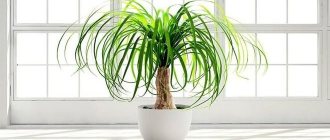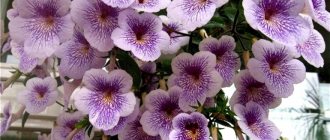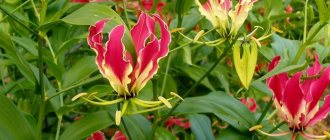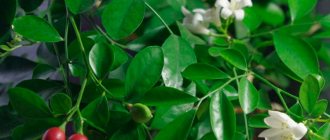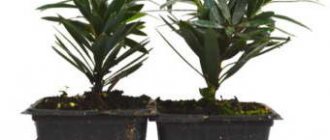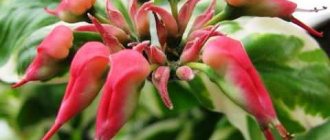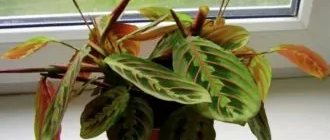Beaucarnea or nolina is a succulent perennial plant from the Asparagus family. In its natural environment it is found in rocky deserts and semi-deserts of North America and in the tropics of South America.
The homeland of bocarnea is Mexico, where, developing most harmoniously, the tree grows up to 10 m. The slender, tall trunk is thickened in the lower part, which is designed to accumulate moisture. Bocarnea develops slowly and unevenly: first, the root zone of the trunk thickens, then its upper part and leaves develop. The leaves grow intensively, descending down in luxurious green curls.
It is not difficult to grow a tree indoors; sometimes it can reach 2 m. Homemade bokarnia does not bloom. In nature, the flowering of nolina is an impressive sight. From a large number of small lilac flowers, it forms large inflorescences similar to panicles.
The plant has several names. One of them, nolina, is associated with the name of biologist and breeder from France P. Nolina. The corky texture of bocarnea bark resembles the skin of an elephant, which is why it is sometimes called “elephant tree.” There are other, less well-known names: “camel tree”, “bottle palm”, “pony tail”.
Be sure to look at a similar plant - dracaena.
| Growth rate is average. |
| Home bokarnia does not bloom. |
| The plant is easy to grow. |
| It is a perennial plant. |
Beneficial properties of bocarnea
Being a natural humidifier and air purifier, bocarnea enriches the air space with air ions and ozone. The plant is used to decorate apartments and offices. It improves the general condition of those in the room and reduces the risk of respiratory diseases. Helps create a favorable atmosphere in the room. In Mexico, sombreros and mats are woven from nolina leaves.
Bokarneya: care at home. Briefly
The big obstacles to growing tropical plants indoors are poor lighting and dry air. Bokarneya grows well at home. You just need to take into account that nolina also has its own preferences:
| Temperature | In the summer season – up to + 20°C, in winter – no higher than + 13°C. |
| Air humidity | Up to 50 %. |
| Lighting | Bright light, south or southeast window. |
| Watering | Rare but plentiful, the soil surface should dry out between waterings. |
| Soil for bocarnaia | Soil for succulents or a mixture of 2 doses of leaf soil, 1 dose of brick chips, 2 doses of clay, 1 dose of sand. |
| Feeding and fertilizer | In summer, once every 15 days, apply fertilizer to succulents. |
| Beaucarnea transplant | .Young bushes - in spring, once every 2.5 years; adults – once every 4.5 years; mature ones do not need to be replanted; only the top layer of the substrate is refreshed. |
| Reproduction | Seeds and apical cuttings. |
| Features of growing bokarneya | For better branching it requires mandatory pinching. |
In order for the plant to look impressive, the gardener must know the peculiarities of growing bocarnea. The tree requires careful care. You need to wipe the leaves carefully: they are very hard and sharp at the edges. When cracks appear on the nolina trunk, they are covered with garden pitch.
To give the plant a unique look, several specimens are planted in one pot at the same time. Planted close to each other, they gradually merge together, forming a powerful trunk. Trimming the tops at different levels allows you to form a stylish crown.
Errors in care and their elimination
If not maintained properly, the plant will develop diseases. Errors in care and problem solving:
| Description of the problem | Possible reasons | Remedies |
| The greenery turns yellow and falls off. | There is increased dampness in the room. | Ventilate the room regularly and maintain a comfortable temperature. |
| The stem dries out and becomes wrinkled. The leaves are withering. | Soil drying out. | Water more often. |
| The tips of the leaf blades turn brown. | Excessive watering. | Water as recommended. |
| During the season, foliage grows slowly. | Lack of nutrients. | Feed in spring and summer. |
| The greenery is limp and drooping, a darker shade than it should be. | Bad light. | Move the pot closer to the window or create additional lighting using lamps. |
| Soft plaques form on the trunk. The shoots soften and the rhizome rots. | Constant presence of moisture. Water entering the trunk. This is aggravated by low temperatures. |
|
| The lower foliage dries and falls off, but new greenery grows quickly. | This is normal. | Everything is fine. The bush is healthy. |
| The trunk softened. | Rotting as a result of excess water. | When the trunk rots, the bocarney dies. |
Caring for bokarneya at home. Details
Home bokarnia is an unpretentious plant, but in order for its unique beauty to be fully revealed, you need to create optimal conditions.
Flowering nolina, bocarnea
Under natural conditions, only mature bocarnea blooms, forming many tiny light lilac flowers collected in panicles.
Beautiful long inflorescences descend from the top of the tree, spreading a delicate aroma around. Flowering of nolina and bocarnea at home is impossible. The plant only occasionally forms a peduncle, which is pinched to form a beautiful crown.
Temperature
To make the tree look attractive, it is necessary to maintain a certain temperature regime. In winter, the nolina plant should be kept at + 7 – 13°C. In summer, it is advisable that the thermometer does not rise above + 20°C.
Drafts are contraindicated for the tree (especially in combination with high humidity).
Spraying
Bocarnea prefers average air humidity, so spraying is carried out only in hot weather with dry soil. They do this carefully, trying not to touch the trunk. Sometimes the foliage is wiped with a clean soft cloth.
Lighting
The tropical bocarney plant feels great at home in the southeastern and southern zones of the house. It is here that it will receive the bright lighting necessary for development. In less bright places, nolina will slow down, or even stop, its growth.
It is recommended to turn the tree with different sides to the sun to form a beautiful crown. When warm weather sets in in the spring, the plant is taken out into the fresh air. Place away from prevailing winds and drafts. The duration of daylight for normal development of bocarnea should be at least 10 hours. In winter, phytolamps are turned on.
Watering bocarneya
Excess moisture can destroy nolina.
Enough time should pass between waterings so that the surface of the substrate has time to dry. Bokarneya is watered infrequently, but quite abundantly: in the summer - every 5 days, in the autumn and spring - after 12 days. In winter, watering is stopped. The colder it is outside, the less often you should water. A clear sign of the need for watering is the shrinking and softening of the trunk. Use settled lukewarm water.
Nolina pot
The root system of the plant is located superficially, so nolina grows favorably at home and feels good in a low, wide container. Each new pot for nolina should be 2.5 cm larger than the previous one and stand steadily on a flat surface.
When determining the height of the pot, you need to understand that 1/3 of it is filled with drainage. There should be holes made at the bottom of the container for drainage. Mature plants are planted in tubs.
Soil for bocarnaia
Caring for bocarney at home requires planting the plant in a loose, breathable substrate. You can prepare your own soil for bocarnea from two parts of leaf soil and clay and one part of sand and brick chips. You can buy a soil mixture for succulents in the store and supplement it with charcoal powder and chopped sphagnum.
Feeding and fertilizer
When watering the bocarnea, combine feeding and fertilizing with a solution for succulents, diluted by half. The plant is fed only in summer, once every 14 days. After feeding, the plant is kept in the shade for 2 days.
Transfer
Young bushes are replanted once every 2.5 - 3 years, adults - once every 4.5 years, when they need a pot of a larger diameter.
Mature plants that are more than 15 years old should be replanted only in extreme cases: when the root or trunk rots. In other cases, they only refresh the top layer of soil. Bocarnea is transplanted in the spring. This is done very carefully so as not to damage the roots and not to deepen the growing point. After transplantation, nolina can be watered after 4 days, and fed after 2.5 weeks.
How to prune bocarneya?
Plants are pruned to remove damaged parts or to give the crown a neat appearance. Nolina pruning is carried out irregularly, according to the decision of the grower. Each new “haircut” allows the tree to look neat and stylish.
Rest period
Bocarnea can grow tirelessly throughout the year, but rest is necessary for every living creature to prolong its existence and improve its health. A caring owner will artificially create a dormant period for the plant in winter, lowering the temperature to + 13°C, limiting watering and refusing stimulating fertilizing.
In this case, the bokarnia will get stronger over the winter and, healthy, will meet a new spring.
How to care for Nolina recurvata
The bottle tree is unpretentious and thrives indoors.
Bokarneya: home care and popular types
For the nolina plant, caring for it at home means following simple rules.
Placement and temperature
Bokarneya is a light-loving flower. When choosing a place on the windowsill, you should focus on the southwest and southeast directions. Greens should be protected from direct sunlight. Whitish leaves indicate a lack of light.
There is no need to create special temperature conditions; it is enough to maintain the temperature at 20-22 °C.
In summer, the exotic beauty nolina recurvata can be kept on the balcony. Palma nolina loves fresh air, but is afraid of rain, so the balcony must be glazed.
Watering
When caring for nolina, the plant should be watered with boiled water at room temperature as the top layer of soil dries out (on average once every 7 days). The best way is to immerse the pot in a container of water for half an hour.
Excessive soil moisture should be avoided, which contributes to rotting of the bulb and depletion of the stem. Pale and limp greens indicate the need to reduce the amount of watering.
When there is a lack of water, the leaves of the plant collect moisture from the air and send it to the caudex. The trunk of the bent bocarnea begins to grow unevenly, cracks and scars appear on it, and the green crown thins out.
Important! Dry air is indicated by curling leaves, darkening and yellowing of their ends. Spraying or installing a humidifier will help correct the problem.
Soil for indoor nolina
The optimal soil composition is as follows:
- peat - 1 hour;
- turf soil - 2 hours;
- leaf soil - 1 tsp;
- sand - 0.5 tsp;
- vermiculite - 0.5 tsp.
Top dressing
The plant is fed with phosphorus-potassium mixtures once every 20-30 days from September to March. There is no need to add nitrogen fertilizers to the soil, since its excess helps to soften the leaves and leads to a loss of beautiful appearance.
Trimming
It is not necessary to trim the bent bocarnea crown to give it the required shape. Dried leaves of a tree do not fall off, but create a kind of brown halo around the trunk. If yellowed foliage significantly detracts from the appearance, it can be carefully cut off.
For your information! The Beaucarney plant rarely produces a flower when kept at home. Even observing all the care conditions, experienced gardeners cannot achieve the formation of fluffy panicles.
Winter care
In winter, the flower requires a temperature of 10-12 °C. Since at this time the bocarney is in a state of rest, it does not need watering.
From December to February, the palm trunk may shrink due to lack of moisture. In the spring, Nolina will get the required amount of water, and the situation will improve.
In autumn and winter, nolina requires additional lighting. A lamp is installed above the plant for 2-3 hours a day.
Reproduction of nolina, bocarnea
Getting a new tree at home is not easy. Propagation of nolina and bocarnea is possible in two ways.
Growing bocarnea from seeds
Such propagation is complicated by the fact that at first they germinate poorly and then germinate slowly. It takes almost a month to germinate seeds in mini-greenhouses at + 25°C. Further, the plant develops very slowly.
Reproduction of bocarnea by shoots
This is possible only when the side shoots are formed (this does not always happen). The shoot is cut with a sharp knife and treated with a root formation stimulator. Having placed it in the ground, cover it with polyethylene (remove it to ventilate and water the nolina). When the first leaves appear and the plant takes root, the film is removed.
Sometimes the apical shoot of bocarnea is rooted. This breeding option is considered easier and faster.
Reproduction
Beaucarney is usually propagated by seed, because it produces shoots extremely rarely. This happens as follows:
- seeds are soaked in Zircon, Epin;
- pot with substrate, the soil is moistened;
- planting material is evenly distributed and covered with a thin layer of soil;
- the pot is covered with polyethylene and placed under a phytolamp, the temperature is maintained within +21…25˚С;
- The condition of the soil is checked daily (it should always be slightly damp), the film is removed, and condensation is removed from it.
The first shoots appear after 3-4 weeks. The strengthened and grown seedlings are transplanted into different containers.
Longifolia
If nolina has produced shoots that can be separated from the mother bush, then propagation occurs as follows:
- the stalk is separated by hand, the injured area is sprinkled with coal powder;
- the cuttings are planted in a pot with a moistened mixture of peat, sand, and vermiculite;
- the soil around the seedling is slightly compacted;
- the pot is covered with glass, kept at a temperature of +21...26˚С;
- it is regularly watered with water with a small volume of root former, the ground part is sprayed with Zircon, the protective glass is removed daily to eliminate condensation;
- after the greenery appears, as soon as the shoots take root, the shelter is removed.
Propagation of bocarnea by shoots is a simpler method with a good germination rate, but not always possible.
Diseases and pests
Bokarnia is affected by diseases and pests due to illiterate or careless care. The plant changes appearance:
- bocarney leaves become smaller - the container has become small, there is a deficiency of nutrients (replace the container, feed);
- bocarnea leaves turn pale and bend easily - high temperature, little light (move to a cooler and brighter place);
- the tips of the nolina leaves dry out - dry air (spray, place in a tray with wet expanded clay);
- the bocarnea stem shrinks – moisture deficiency (adjust watering);
- Nolina leaves droop and dry - the plant is hot, there is insufficient lighting (reduce the temperature, put it in a brighter place);
- Nolina leaves turn brown and fall off - excess moisture (do not water for several days, then adjust watering);
- the trunk does not grow in thickness - frequent watering, little light (adjust watering, move to a brighter place).
At home, bokarneya may suffer from attacks from scale insects, mealybugs, and spider mites. Insecticides are used against pests.
Transfer
After purchasing indoor nolina, the plant should not be replanted immediately; it needs a week to adapt to the new place. This period will also show the presence or absence of diseases.
Aichrizon flower: care and flowering at home
Transplantation is necessary for active growth of greenery. Adult plants are replanted every 4 years, young plants - once a year.
The pot for transplanting nolina should be wide and shallow. The height of the flowerpot should be approximately 3 times the width. A drainage layer (expanded clay) is placed at the bottom of the container. Next, soil is laid out, the amount of which should be enough to cover the root system (but no more).
The flower should be transferred carefully so as not to damage the fragile roots. The soil should cover 2/3 of the caudex.
Important! Watering is carried out 3-4 days after transplantation.
Transfer
Types of bocarnea, homemade nolina with photos and names
There are approximately 30 species of bocarnaea in the wild. Only a few of them can be grown at home.
Nolina recurvata
The most common type of homemade bocarnea. The height of an adult tree can reach 2 m, the diameter of the thickened part of the trunk is about 1 m. The top of the trunk is “decorated” with sinuous elongated (up to 100 cm) leaves. The dark green leaf blade is narrow (up to 20 mm) and dense. The plant is called “elephant’s foot” based on the shape of its trunk, and “horse’s tail” based on its lush crown.
Nolina Lindheimeriana
A low tree. The trunk is almost invisible. The top is crowned with a lush tuft of elongated narrow leaves, colored light green. The popular name is "devil's lace".
Nolina longifolia
Large powerful tree. The height reaches 4 m. The texture of the trunk resembles a cork covered with cracks. The leaf blades are wide (up to 4.5 cm) and elongated. They have a light green tint.
Bokarneya is a welcome exotic in the house. A stylish plant emphasizes the individuality of the interior, bringing sophistication and elegance to it.
Appearance and common varieties
Nolina is similar to a palm tree, as the green “cap” of the plant is usually located at the top of the trunk. However, it is not related to palm trees, but belongs to the Asparagus family.
What does nolina look like?
Among the popular varieties grown outdoors are the following:
- longifolia - a tree with long foliage and a trunk covered with corky bark;
- Lindemeyra is a plant with a short trunk and a dense tuft of thin leaves hanging to the ground;
- Matapskaya - a two-meter tree with a crown hiding the trunk;
- Nelson's bottle tree is a plant with hard leaves sticking out in different directions, covering most of the trunk.
Popular varieties of the “indoor palm” nolina are:
- compressed - a squat plant with flat long leaves and a bottle trunk;
- thin - a tree with a spherical trunk, growing in bunches of greenery and pink flowers;
- protruding - similar to thin, but has hard protruding leaves;
- recurved (Recurvata) - a plant with a long wide trunk, tapering upward, the ribbon-like rough leaves of which are collected in a bunch at the top of the trunk.
The last variety is especially loved by flower growers.
For your information! For the nolina plant, bocarnea is the second name used in everyday life (the botanical names Nolina Recurvata and Beaucarnea Recurvata are the same thing).
The appearance of the plant is determined by the characteristics of the place of growth. In the arid areas of Southern Mexico and Central America, the thick trunk helps accumulate moisture, and the hard, pointed leaves prevent its rapid evaporation.
In its natural environment, the flower of the nolina plant rises above the crown of the tree and has the shape of a fluffy and thick panicle of pinkish petals.
In the wild, bocarnea recurvata grows up to 8 m, at home - up to 1.5 m.
Blooming nolina in nature
Note! For the indoor flower nolina, bottle tree is the most popular of the popular names, obtained due to the unusual shape of the trunk. The plant is also called elephant's foot and horse's tail (due to its narrow and long leaves).

